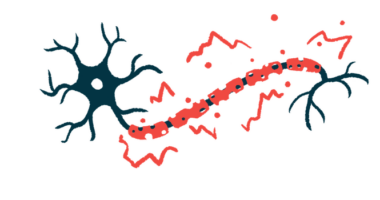Elevated Protein Levels May Help Diagnose, Monitor CMT, Study Finds

The proteins NCAM1 and GDF15 are present at higher-than-normal levels in the blood of people with Charcot-Marie-Tooth disease (CMT), and in mouse models of the disease, a new study indicates.
Scientists think these proteins may be useful biomarkers across types of CMT.
The study, “NCAM1 and GDF15 are biomarkers of Charcot-Marie-Tooth disease in patients and mice,” was published in Brain.
Biomarkers are objective biological measures — levels of a protein in the blood, for example — that can give information about a person’s health status, such as the presence or severity of a disease. Biomarkers can be useful for diagnosing patients, as well as monitoring the severity of a condition over time and assessing a treatment’s impact.
The different types of CMT are characterized by problems with the peripheral nervous system, which controls movement and sensation, but the underlying biological causes are different. While a few types of CMT have disease-specific biomarkers, other forms have no established biomarkers.
To identify biomarkers across types of CMT, the international research team analyzed blood samples from four mouse models of different CMT types. They also analyzed blood samples from 41 CMT patients. Wild-type (healthy) mice and samples from 12 people without CMT were used as controls.
The most common subtypes among the study’s CMT patients were CMT1A (21 people), CMT2N (six), CMT2D (four), and CMT2Q (three). The remaining participants all had different disease subtypes.
Results showed that levels of NCAM1 were significantly higher in CMT patients than controls by 22.2%. This protein’s levels also were elevated in mouse models, and NCAM1 levels were associated with symptom severity in both mice and people.
“We propose that NCAM1 may be a biomarker of CMT with potential capacity to monitor disease-progression, as demonstrated in patients and in several mouse models,” the researchers wrote.
Statistical analyses indicated that NCAM1 levels could distinguish between CMT patients and controls with a sensitivity (true-positive rate) of 78% and a specificity (true-negative rate) of 70%, at a cutoff value of 44.34 nanograms per milliliter.
The scientists concluded that “NCAM1 can be used as a diagnostic biomarker with good selectivity between CMT patients and controls.”
Researchers noted that NCAM1 may play roles in nerve cells’ functioning and communication. They said further study was needed to see if this protein would respond to treatments that ease the severity of nerve damage in CMT.
The protein GDF15 also was elevated in CMT patients and in mouse models, compared to controls. Among the patients, average GDF15 levels were nearly three times higher than in people without CMT. At a cutoff of 411.8 picograms per milliliter, GDF15 levels could distinguish between CMT and non-CMT with a sensitivity of 94% and a specificity of 93%.
“We observed an early elevation of GDF15 in CMT and a significant relationship to disease severity among mildly affected … patients,” the researchers wrote.
“Our data indicates that serum [blood] GDF15 is a very strong diagnostic biomarker of CMT,” they added.
GDF15 may help to promote nerve cell growth, the scientists noted, suggesting that high GDF15 levels in CMT might be a result of the body’s effort to heal damage caused by the disease.
Results also indicated that proteins related to the complement system — a group of inflammatory proteins in the blood — were increased in the CMT patients and mouse models. These showed no association with disease severity, however.
“Understanding the role of the complement system in the [disease mechanism] of CMT warrants future work,” the scientists wrote.
The team concluded that these biomarkers may be useful, separately or in combinations, to identify CMT and monitor its progression or responses to treatments.
“Further studies in larger CMT cohorts, including longitudinal studies, should be conducted to validate the clinical value of these biomarkers for clinical and trial use,” the researchers said.







